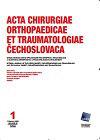The Anti-Inflammatory Effect of miR-140-3p in BMSCs-Exosomes on Osteoarthritis.
IF 0.4
4区 医学
Q4 ORTHOPEDICS
Acta chirurgiae orthopaedicae et traumatologiae Cechoslovaca
Pub Date : 2023-08-15
DOI:10.55095/achot2023/032
引用次数: 0
Abstract
PURPOSE OF THE STUDY Articular cartilage injury is a common disease in daily life, with a high incidence. The aim of this study was to investigate the effect and mechanism of miRNA-140-3p in bone mesenchymal stem cells (BMSCs)-derived exosomes under hypoxia on inflammatory articular chondrocytes. MATERIAL AND METHODS To simulate the pathological status of arthritis, rat chondrocytes were used to establish the osteoarthritis (OA) model by IL-1β (10 μg/ml) as a modulating in vitro, and exosomes were isolated by differential ultra-high speed centrifugation. The cell counting kit-8, wound healing and flow cytometry assays were utilized to assess proliferation, migration and apoptosis of chondrocytes, respectively. Lipogenic and chondrogenic differentiation of chondrocytes were detected by oil red O staining and toluidine blue staining individually. The expressions of miR-140-3p and chondrocyte-specific gene mRNA were investigated using qRT-PCR. Western blot was applied to assess chondrocyte associated proteins and BMSC-Exo surface protein markers, and immunohistochemistry was adopted to detect the staining of collagen I and II. RESULTS Under scanning electronic microscope, the shape of exosomes was almost round. Exosome treatment prominently impaired the inhibition of chondrocytes' proliferative and migrative ability by IL-1β. It was found hypoxia had a more marked impact on proliferation, expression of collagen II and apoptosis in OA chondrocytes than normoxia, as well as a stronger effect on weakening adipose differentiation and enhancing chondrogenic differentiation in inflammatory chondrocytes. Furthermore, incubation with BMSC-Exo overexpressing miR-140-3p can remarkably increase the survival rate and migration in inflammatory chondrocytes. In addition, overexpression of miR-140-3p was found to enhance the chondrogenic differentiation of inflammatory chondrocytes. Furthermore, we found that the healing effect of exosomes on inflammatory chondrocytes under hypoxic conditions was produced by a rise in miR-140-3p expression within them and that hypoxia-mediated upregulation of miR-140-3p expression occurred through HIF-1α. CONCLUSIONS Under hypoxia, BMSC-Exo enhanced the chondrogenic phenotype, increased the viability of inflammatory chondrocytes. The overexpression of miR-140-3p in BMSC-Exo is beneficial to protect joints and delaying the pathogenesis in OA. Key words: HIF-1α, apoptosis, lipogenic differentiation, chondrogenic differentiation.骨髓基质干细胞外泌体中miR-140-3p对骨关节炎的抗炎作用。
关节软骨损伤是日常生活中常见的疾病,发病率高。本研究旨在探讨缺氧条件下骨间充质干细胞(BMSCs)来源外泌体中miRNA-140-3p对炎性关节软骨细胞的影响及其机制。材料与方法采用IL-1β (10 μg/ml)作为体外调节剂,利用大鼠软骨细胞建立骨关节炎(OA)模型,采用差速超高速离心分离外泌体,模拟关节炎的病理状态。利用细胞计数试剂盒-8、伤口愈合和流式细胞术分别评估软骨细胞的增殖、迁移和凋亡。分别用油红O染色和甲苯胺蓝染色检测软骨细胞的脂质分化和软骨分化。采用qRT-PCR检测miR-140-3p和软骨细胞特异性基因mRNA的表达。Western blot法检测软骨细胞相关蛋白和BMSC-Exo表面蛋白标志物,免疫组化法检测I、II型胶原染色。结果扫描电镜下,外泌体形状接近圆形。外泌体处理显著损害了IL-1β对软骨细胞增殖和迁移能力的抑制。我们发现缺氧对OA软骨细胞增殖、II型胶原表达和凋亡的影响比常氧更显著,对炎性软骨细胞脂肪分化减弱、软骨分化增强的作用更强。此外,与过表达miR-140-3p的BMSC-Exo孵育可以显著提高炎症软骨细胞的存活率和迁移能力。此外,研究发现过表达miR-140-3p可增强炎性软骨细胞的成软骨分化。此外,我们发现缺氧条件下外泌体对炎性软骨细胞的愈合作用是通过miR-140-3p表达的升高产生的,并且缺氧介导的miR-140-3p表达上调是通过HIF-1α发生的。结论缺氧条件下,BMSC-Exo可增强软骨细胞表型,提高炎性软骨细胞活力。miR-140-3p在BMSC-Exo中过表达有利于保护关节,延缓OA发病。关键词:HIF-1α,细胞凋亡,脂质分化,软骨分化
本文章由计算机程序翻译,如有差异,请以英文原文为准。
求助全文
约1分钟内获得全文
求助全文
来源期刊
CiteScore
0.70
自引率
25.00%
发文量
53
期刊介绍:
Editorial Board accepts for publication articles, reports from congresses, fellowships, book reviews, reports concerning activities of orthopaedic and other relating specialised societies, reports on anniversaries of outstanding personalities in orthopaedics and announcements of congresses and symposia being prepared. Articles include original papers, case reports and current concepts reviews and recently also instructional lectures.

 求助内容:
求助内容: 应助结果提醒方式:
应助结果提醒方式:


